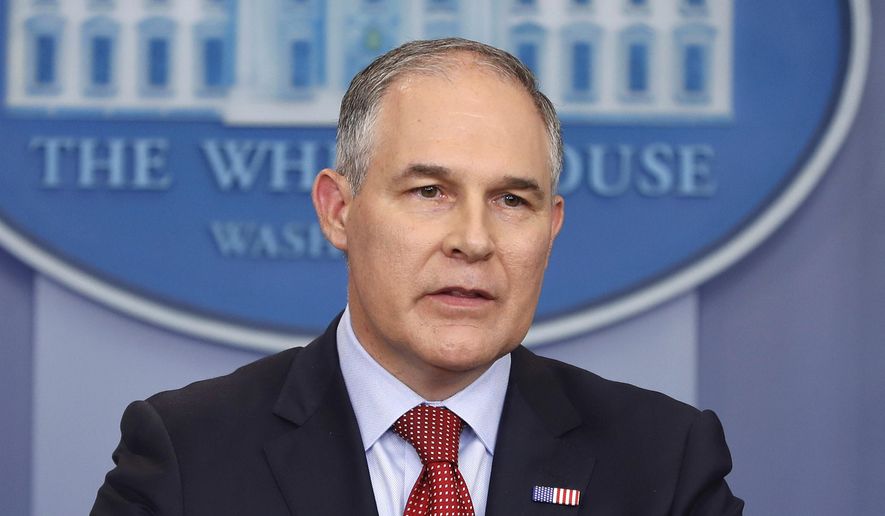The Environmental Protection Agency’s repeal of the Obama-era Clean Power Plan doesn’t necessarily let the Trump administration off the hook, environmental groups and legal scholars say, and the government may have to show courts that it intends to address carbon pollution from power plants in some way, shape or form.
Last week, EPA Administrator Scott Pruitt announced a process to formally undo the CPP, which called for harsh limits on power-plant emissions and was specifically designed to curb the use of coal. The CPP, a central piece of former President Barack Obama’s climate change agenda, was legally dubious at best; indeed, the Supreme Court blocked the plan in early 2016, and it never actually went into effect.
But specialists say that just because Mr. Pruitt is dismantling the flawed CPP doesn’t mean he’ll be able to ignore power plant pollution altogether. The EPA seemed to acknowledge as much last week when it left open the door to another rule addressing carbon.
“Any replacement rule will be done carefully, properly, and with humility, by listening to all those affected by the rule,” Mr. Pruitt said.
Several high-profile Supreme Court cases, beginning with 2007’s Massachusetts v. EPA, gave the agency power to regulate carbon pollution and other greenhouse gases under the federal Clean Air Act. The ruling didn’t explicitly order any specific rules on carbon emissions from power plants, however, and instead compelled the agency to research the matter further and justify whatever action it decided to take.
As a result, the Obama administration’s EPA in 2009 produced its controversial “endangerment finding,” a lengthy research document that became the scientific underpinning for the CPP and other climate measures. It made the case that, among other things, carbon emissions are a threat to human health and drive climate change.
With that finding still in place — and there have been no signs Mr. Pruitt will try to reverse it — scholars say the EPA will have to produce something related to carbon and power plants or risk being seen as ignoring a high court order.
Its conclusion could be as simple as saying the agency studied the issue and determined emissions limits on existing plants simply aren’t necessary.
“The basic answer is they have to do something, but what that means could involve not adopting a standard for these existing coal power sources,” said James Coleman, a law professor at Southern Methodist University who specializes in energy and regulatory issues. “They have to say what they’re going to do, but what they could say is, ’We’re not going to adopt any regulations.’”
Indeed, EPA could argue that power plants are already regulated under Clean Air Act standards governing mercury and other pollutants. Or the agency may argue limits on existing plants would be far too expensive and could result in energy price spikes for consumers.
Put simply, the agency could do little or nothing, but it will have to make a compelling scientific and legal argument as to why that’s the right course of action.
But environmentalists see the situation much differently. They argue that because the Supreme Court has classified carbon as a dangerous greenhouse gas that should be addressed, the EPA can’t ignore a major source of emissions such as existing power plants.
“Whether it’s straight repeal or repeal-plus-do-nothing-replacement, the Trump/Pruitt Dirty Power Plan will not meet EPA’s obligations under the law,” said David Doniger, director of the climate and clean air program at the Natural Resources Defense Council. “The law requires EPA’s standards to be effective — a standard doesn’t represent the ’best system of emission reduction’ if it does not achieve as much carbon pollution reduction as can be accomplished at an acceptable cost.”
Powerful environmental groups already have vowed to sue Mr. Pruitt over his repeal of the CPP, ensuring the matter eventually ends up in court.
For congressional Republicans, the original intent of the Clean Air Act is at the heart of the matter. They argue that the landmark legislation was never intended to apply to carbon emissions, no matter how many regulations or court verdicts contend otherwise.
“The notion that carbon is a pollutant under the Clean Air Act is based on the false premise that Congress intended it to be classified as such when the CAA originally passed,” said Rep. Paul Gosar, Arizona Republican and chairman of the Congressional Western Caucus. “Calls to regulate carbon in pursuit of the climate agenda came after the fact, or carbon regulation would have been included in the original CAA implementation.”
That argument from Republican leaders will push Mr. Pruitt to do nothing, though it would seem doing something, even a rule with marginal impact, would be a much safer bet from a legal perspective.
“They could adopt some standards that require some efficiency improvements — a within-the-fence approach,” Mr. Coleman said, referring to the legal debate over whether the EPA has the authority to impose rules that reach “beyond the fence line” of a pollution source and affect the power system as a whole.
In addition to the fact Mr. Pruitt himself has very clearly left the door open to a replacement rule, leading pro-business groups also seem keen to find a more modest way to address power-plant emissions.
“We welcome the opportunity to work with the EPA and other stakeholders to develop power plant standards that lower emissions, preserve America’s energy advantage, and respect the bounds of the Clean Air Act,” said Karen Harbert, president and CEO of the U.S. Chamber of Commerce’s Global Energy Institute.
• Ben Wolfgang can be reached at bwolfgang@washingtontimes.com.




Please read our comment policy before commenting.